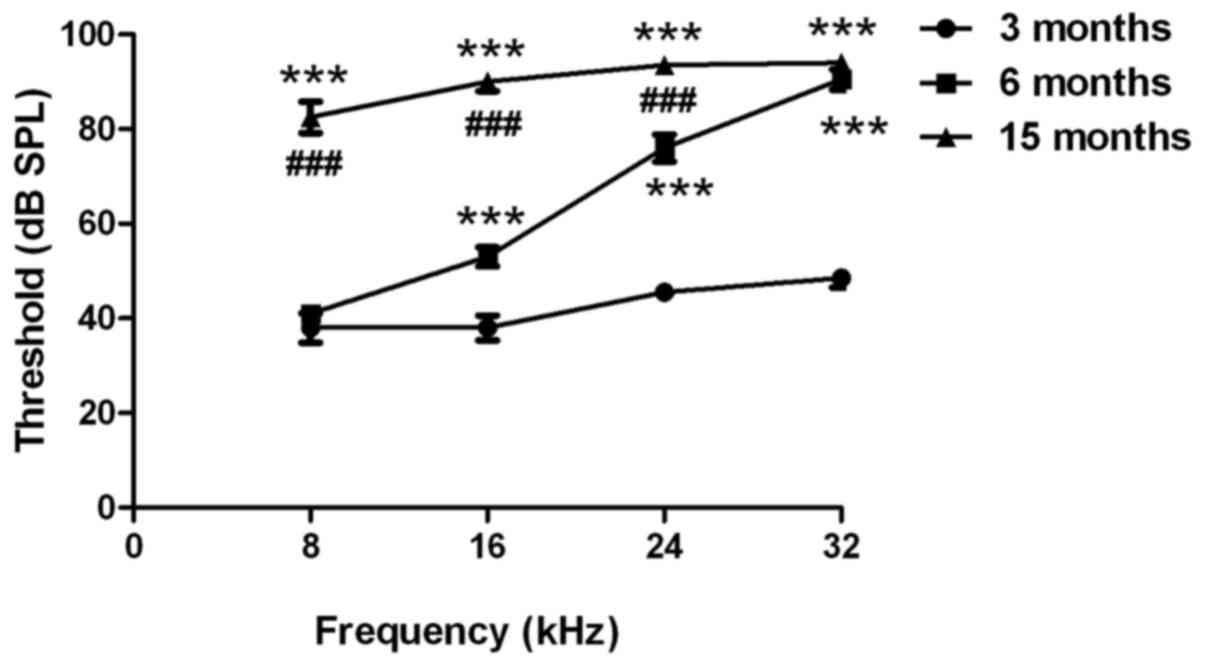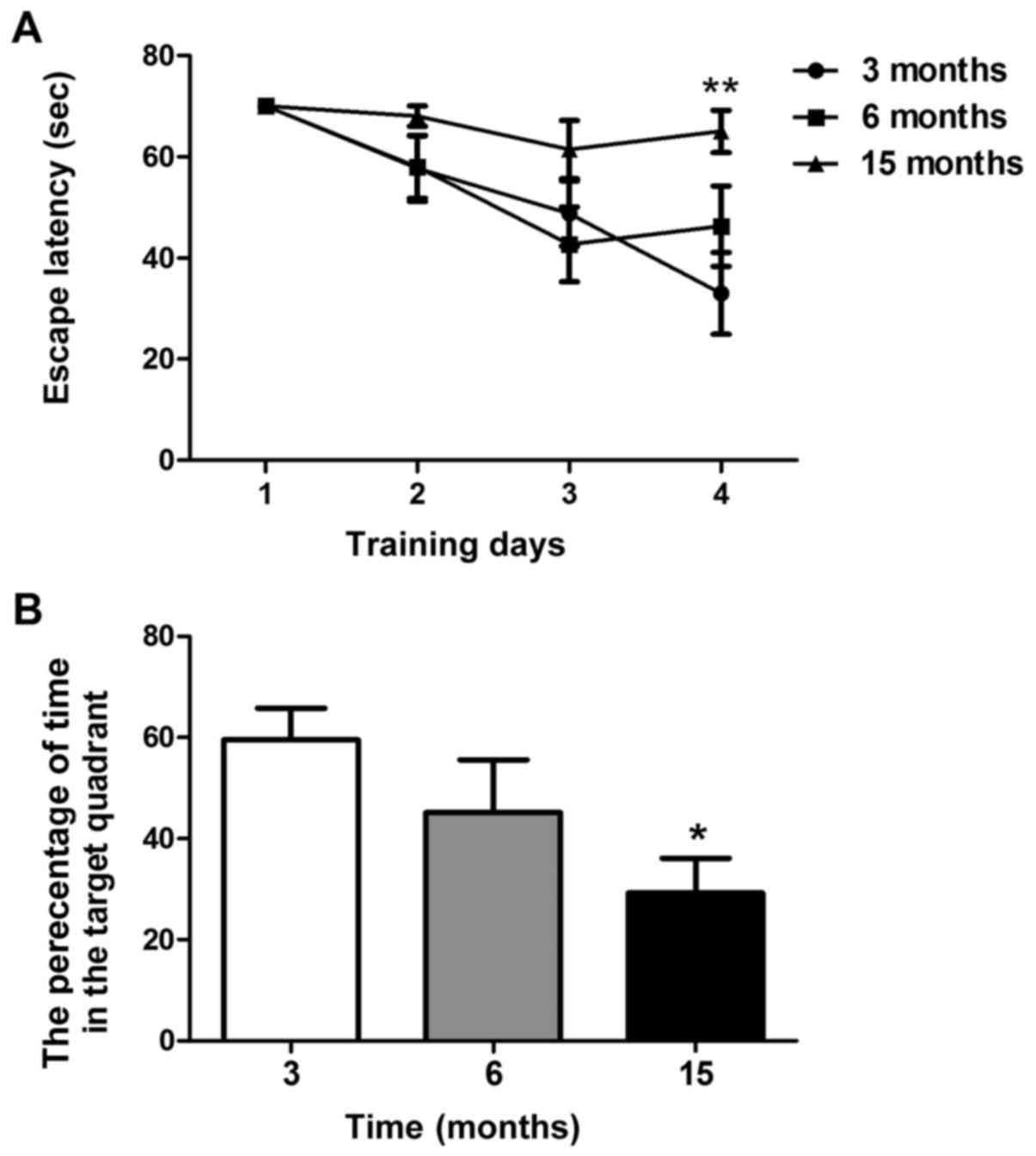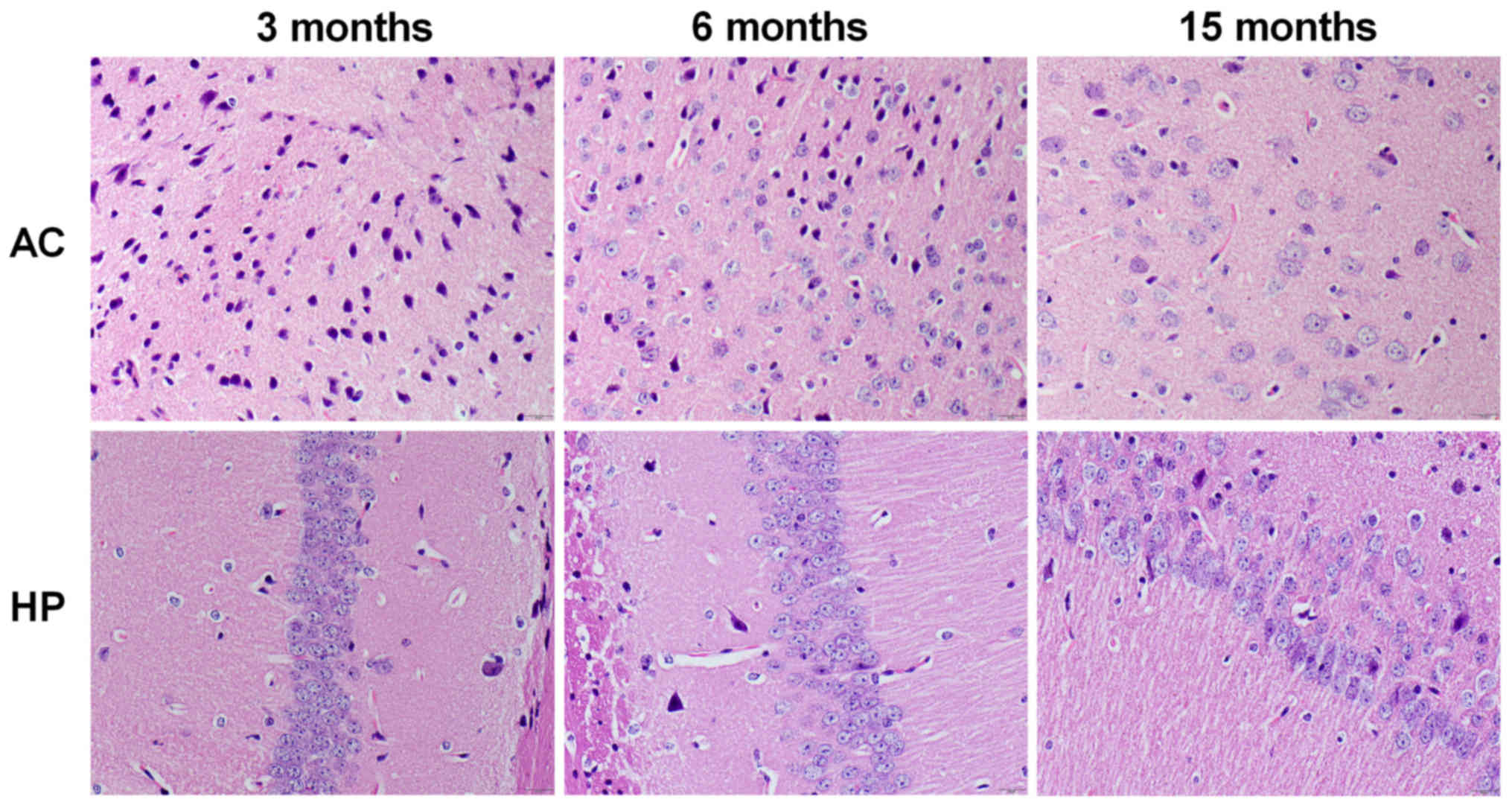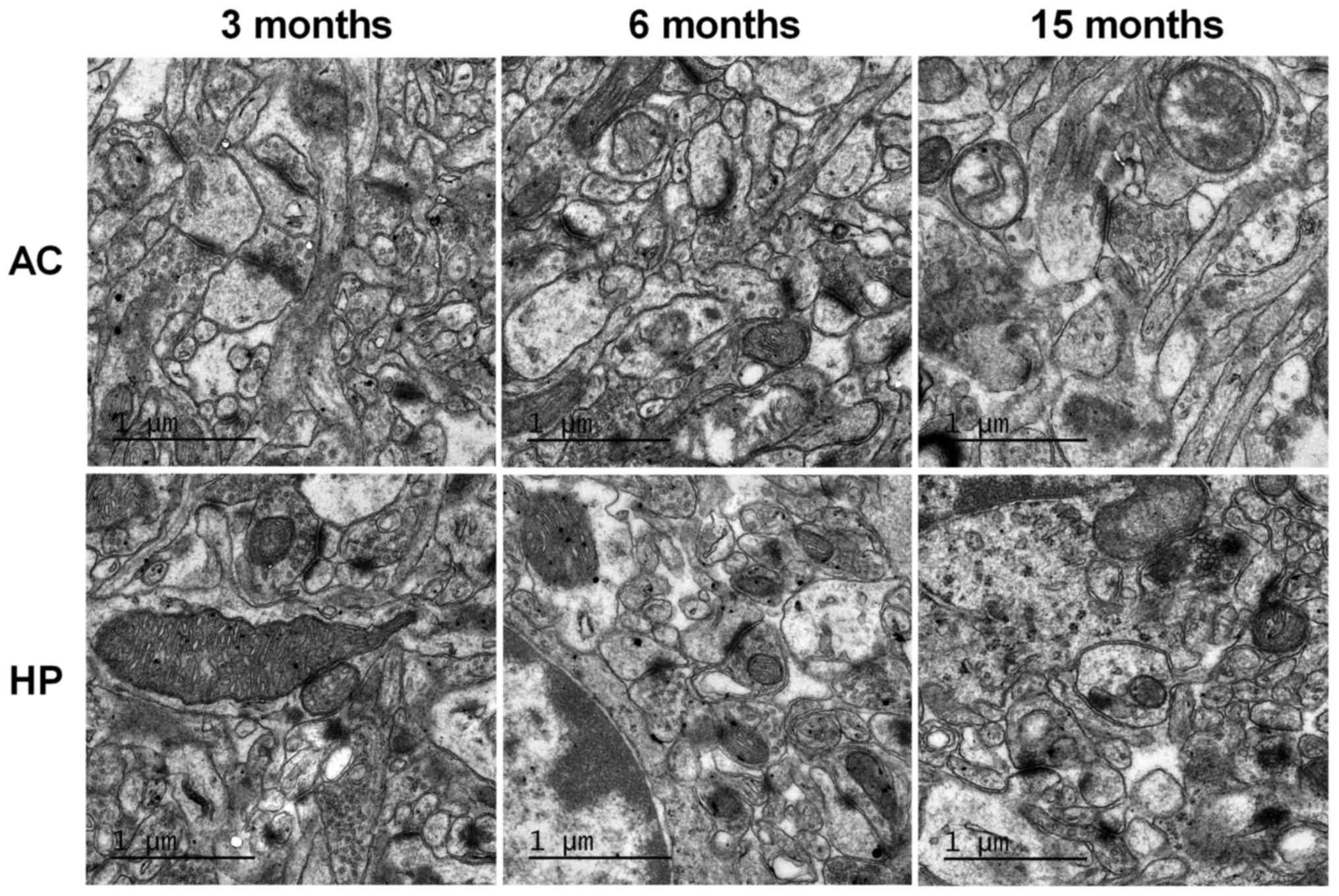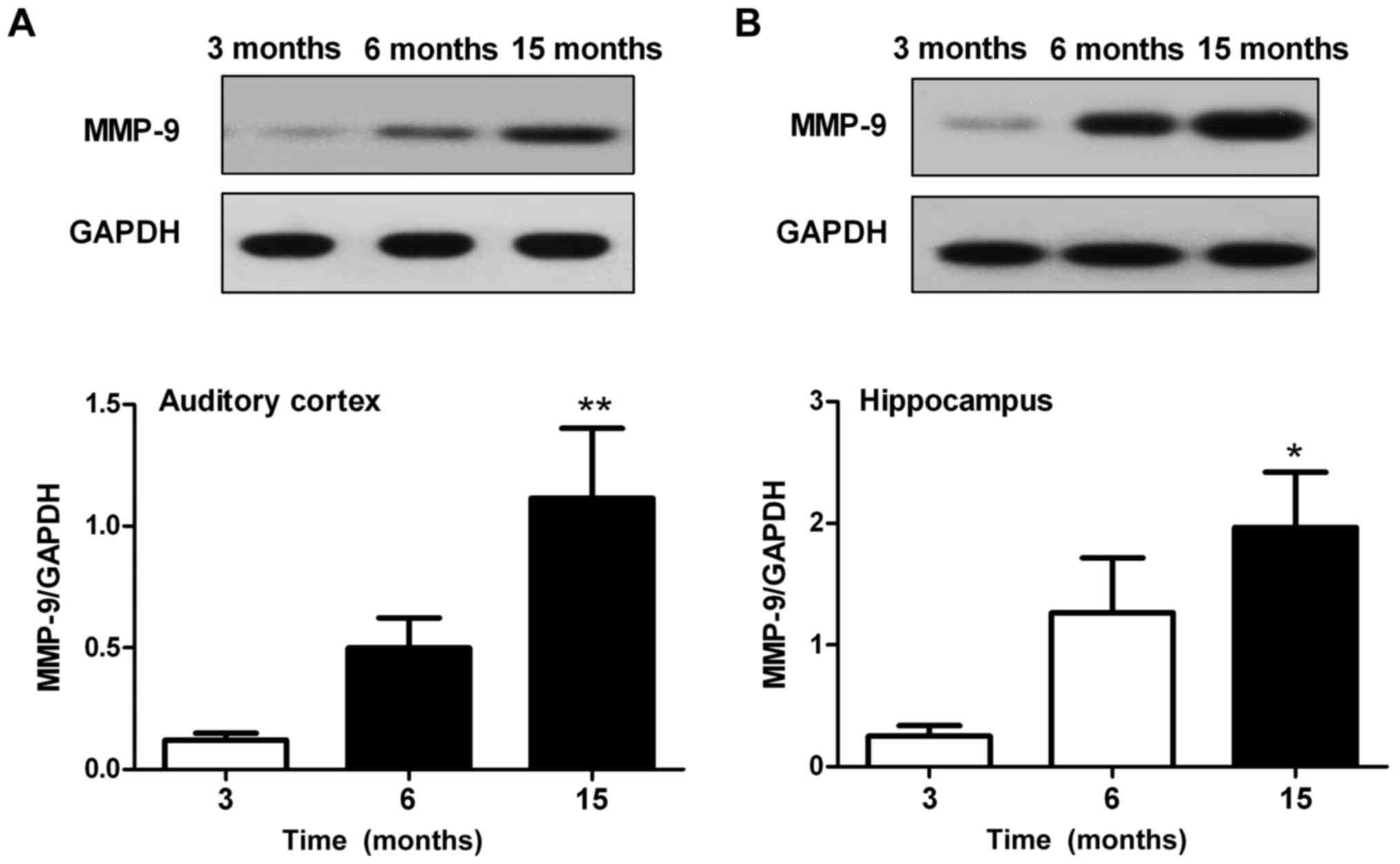Association between age‑related hearing loss and cognitive decline in C57BL/6J mice
- Authors:
- Published online on: June 1, 2018 https://doi.org/10.3892/mmr.2018.9118
- Pages: 1726-1732
Abstract
Introduction
A link between age-related hearing loss and cognitive decline has been supported by numerous studies (1–4). In recent years, such studies have demonstrated that hearing loss may serve a causal role in cognitive decline (1–4). In addition, it has been reported that central auditory dysfunction significantly increases the risk of dementia (5). The rates of cognitive decline and the risk for incident cognitive impairment are linearly associated with the severity of an individual's baseline hearing loss, which indicates that hearing loss is independently associated with accelerated cognitive decline and incident cognitive impairment in community-dwelling older adults (2,6).
Although the mechanisms underlying this association are unclear, a reliable relationship between age-related hearing loss and cognitive decline is considered to exist. If hearing loss can lead to cognitive decline, the use of hearing aids or other rehabilitative strategies much earlier in the course of hearing loss may be valuable in the prevention of cognitive decline or Alzheimer's disease, which has important healthcare and public policy implications (7,8). Therefore, it is necessary to determine the effects of age-related hearing loss on cognitive decline and to explore the mechanisms underlying the association between them.
Age-related hearing loss, also referred to as presbycusis, is associated with the deterioration of central and peripheral auditory systems (9–12). Age-related dysfunction and degeneration of the auditory cortex in age-related hearing loss have been detected in humans and in numerous animal models (13–16). It is well known that the hippocampus is associated with memory formation and recognition, and participates in auditory information processing (17,18). Direct and indirect connections between the auditory pathway and the hippocampus exist, and auditory system activity induces hippocampal plasticity (12,19). A direct connection between the CA1 hippocampal region and the auditory association cortex, and even to the primary auditory cortex, has been detected in rats (19). Therefore, auditory cortex-hippocampus interactions may be involved in the mechanisms underlying the association between age-related hearing loss and cognitive decline.
C57BL/6J mice are widely used as a model of presbycusis, since they exhibit progressive hearing loss (20–22). C57BL/6J mice, but not CBA/CaJ mice, clearly exhibit decreased performance in the Morris water maze test and degeneration of synapses within the hippocampus, which demonstrate that the age-related hearing loss is accompanied by the degeneration of synapses in the hippocampal CA3 region (23). Conversely, CBA/CaJ mice retain the majority of their hearing sensitivity up to 18 months of age, further supporting the association between age-related hearing loss and cognitive decline (24). The present study aimed to determine the association between age-related hearing loss and cognitive decline in C57BL/6J mice, and to explore the mechanisms underlying this association.
Materials and methods
Animals
The present study was approved by the Ethics Committee of Shanghai University of Traditional Chinese Medicine (Shanghai, China). Male C57BL/6J mice at the following ages were used in the present study: Young mice (25±2 g), 3 months old; adult mice (31±2 g), 6 months old; and middle-aged mice (40±3 g), 15 months old (n=10 mice/group). All of the mice were obtained from Shanghai SLAC Laboratory Animal Co., Ltd. (Shanghai, China). The animals were maintained under a 12-h light/dark cycle at 20–26°C and 40–70% humidity, and were allowed free access to normal food and water until experimentation.
Auditory brainstem response (ABR) test
Each mouse was anesthetized via intraperitoneal injection with sodium pentobarbital (100 mg/kg). ABRs were recorded using a TDT-III system with BioSig32 software (both Tucker-Davis Technologies, Alachua, FL, USA). Tone burst stimuli were generated at the following frequencies: 8, 16, 24 and 32 kHz. The average response to 1,000 repetitive stimuli was obtained by reducing the intensity at 5 dB sound pressure level (SPL) intervals from 90 dB SPL. The ABR threshold was defined as the lowest dB level at which a response could be visually detected.
Morris water maze
The water maze used in the present study consisted of a circular pool (diameter, 120 cm; height, 30 cm), which included a hidden platform, and a video camera-based computer tracking system (DigBehv-MM water maze; Shanghai Jiliang Software Technology Co., Ltd., Shanghai, China). The water temperature in the circular pool was maintained at 22±1°C. The platform was submerged 1 cm below the water level. During the 4-day hidden platform test, the time spent taken to find the hidden platform (latency) was recorded. If the mouse could not find the platform, it was placed on the platform for 30 sec. On the fifth day, the platform was removed and the probe trial was performed. The percentage of time spent in the previous platform quadrant, also known as the target quadrant, was recorded.
Hematoxylin and eosin staining
Following anesthetization via intraperitoneal injection with sodium pentobarbital (120 mg/kg), animals were immediately sacrificed by cervical dislocation. The brain tissues were removed quickly on ice and fixed in 4% paraformaldehyde overnight at 4°C. Following dehydration in a graded series of alcohol, tissues were embedded in paraffin and sliced into 4 µM sections. The sections were stained with hematoxylin for 7 min and eosin for 2 min. Subsequently, the sections were observed and images were captured under a microscope (BX53; Olympus Corporation, Tokyo, Japan) after mounting. The location of the hippocampus and auditory cortex was identified in accordance with the mouse brain stereotaxic coordinates described by Paxinos and Franklin (25).
Transmission electron microscopy (TEM)
The hippocampus and auditory cortex tissues were perfused and fixed with 2.5% glutaraldehyde overnight at 4°C. Following post-fixation in 1% osmium tetroxide for 2 h at room temperature, the tissues were dehydrated in an ascending graded ethanol series at 4°C and acetone series at room temperature. Subsequently, tissues were immersed in acetone/Epoxy 618 mixture for 2 h and Epoxy 618 for 2 h, and were finally embedded in Epoxy 618 for 12 h at 37°C and for 8 h at 60°C. Serial ultrathin sections (50 nm) were collected on copper grids and stained with lead citrate. The ultrastructure of the stained sections was examined under a transmission electron microscope (Tecnai G2 Spirit; FEI; Thermo Fisher Scientific, Inc., Hillsboro, OR, USA).
Western blot analysis
The hippocampus and auditory cortex tissues were lysed in radioimmunoprecipitation acid lysis buffer containing protease inhibitor (Shanghai Weiao Biotechnology Co., Ltd., Shanghai, China). Protein concentrations were determined using a Bicinchoninic acid protein assay kit (Beyotime Institute of Biotechnology, Haimen, China). Proteins (40 µg) were then subjected to electrophoresis on 12% polyacrylamide gels and were transferred to polyvinylidene difluoride membranes by electrotransfer (Bio-Rad Laboratories, Inc., Hercules, CA, USA). The membranes were blocked with 5% non-fat milk in Tris-buffered saline containing 0.5% Tween-20 for 1 h at room temperature, and were then incubated overnight with matrix metalloproteinase-9 (MMP-9; cat. no. AF909; 1:800; R&D systems, Minneapolis, MN, USA) and GAPDH (cat. no. 2118S; 1:1,000; Cell Signaling Technology, Inc., Danvers, MA, USA) primary antibodies at 4°C. Subsequently, the membranes were washed and incubated with the following corresponding secondary antibodies: HRP conjugated rabbit anti-goat IgG (cat. no. ab6741; 1:2,000; Abcam, Cambridge, UK) and HRP conjugated goat anti-rabbit IgG (cat. no. AP132P; 1:2,000; Merck KGaA, Darmstadt, Germany) for 2 h at room temperature. Finally, the protein bands were visualized with Enhanced Chemiluminescence Plus Western blotting detection reagents (GE Healthcare, Chicago, IL, USA). The relative levels of the target protein compared with GAPDH were determined via densitometric analysis using ImageJ software (version 2.1.4.7; National Institutes of Health, Bethesda, MD, USA).
Statistical analysis
Data are presented as the mean ± standard error of the mean. Statistical analysis was conducted using GraphPad Prism 5.0 (GraphPad Software, Inc., La Jolla, CA, USA). Multiple comparisons were made by one-way analysis of variance and Turkey's post hoc multiple comparison test. P<0.05 was considered to indicate a statistically significant difference. Pearson correlation analysis was performed to investigate the association between hearing threshold with the escape latency and percentage of time in the target quadrant.
Results
Age-related hearing loss
An ABR test was used to evaluate the hearing function of C57BL/6J mice. As presented in Fig. 1, the hearing thresholds at 16, 24 and 32 kHz were significantly higher in 6-month-old mice compared with in 3-month-old mice (P<0.001). The hearing thresholds at 8, 16, 24 and 32 kHz were significantly higher in the middle-aged group (age, 15 months) compared with in the 3-month-old mice (P<0.001). In addition, the hearing thresholds at 8, 16 and 24 kHz were significantly higher in the 15-month-old mice compared with in the 6-month-old mice (P<0.001). These findings suggested that the C57BL/6J mice exhibited age-related hearing loss.
Age-related spatial learning and memory decline
A Morris water maze test was used to examine spatial learning and memory in C57BL/6J mice. As shown in Fig. 2A, the time taken to find the submerged platform decreased every day in mice aged 3 and 6 months; however, this phenomenon was not observed in 15-month-old mice. On the fourth training day, the escape latency of 15-month-old mice was significantly higher than that of 3-month-old mice (P<0.01). However, there was no significant difference between the 6-month-old and 3-month-old mice (Fig. 2A). As shown in Fig. 2B, 15-month-old mice spent less time in the target quadrant compared with the 3-month-old mice in the probe test on day 5 (P<0.05). No significant differences were revealed between the 6-month-old and 3-month-old mice. These findings suggested that 15-month-old mice, but not 6-month-old mice, may exhibit significant spatial learning and memory decline.
Correlation between age-related hearing loss and cognitive decline
Pearson correlation analysis was used to determine the correlation between age-related hearing loss and cognitive decline. Results demonstrated that escape latency was positively correlated with hearing threshold at 16 kHz (R=0.691, P<0.001; Fig. 3B) and percentage of time in the target quadrant was negatively correlated with hearing threshold at 16 kHz (R=−0.469, P<0.01; Fig. 3B). These findings indicated that a positive correlation exists between age-related hearing loss and cognitive decline.
Pathological alterations in the auditory cortex and hippocampus
As presented in Fig. 4, the number of neurons in the auditory cortex and hippocampal CA1 region was markedly decreased in 15-month-old mice compared with in 3-month-old mice, but not in 6-month-old mice. Furthermore, pyramidal neurons in the hippocampal CA1 region exhibited a disorganized arrangement in the 15-month-old mice; however, no marked alterations were detected in 6-month-old mice.
Ultrastructural alterations in the auditory cortex and hippocampus
TEM was used to observe synaptic ultrastructure in the auditory cortex and hippocampus. As shown in Fig. 5, there was no marked difference between the 6-month-old and 3-month-old mice. However, synaptic number and synaptic vesicle density were markedly decreased in the 15-month-old mice compared with in the 3-month-old mice.
Alterations in the protein expression levels of MMP-9 in the auditory cortex and hippocampus
Western blotting was used to assess the protein expression levels of MMP-9 in the auditory cortex and hippocampus. Results revealed that MMP-9 expression in the auditory cortex (Fig. 6A) and hippocampus (Fig. 6B) was significantly enhanced in the 15-month-old mice compared with in the 3-month-old mice (P<0.05). There were no significant differences in MMP-9 expression between the 6-month-old and 3-month-old mice in the auditory cortex and hippocampus; however, MMP-9 expression was slightly increased in the 6-month-old mice.
Discussion
In the present study, significant hearing loss, but not cognitive decline, was detected in 6-month-old C57BL/6J mice. However, 15-month-old mice exhibited severe hearing loss and obvious cognitive decline. Correlation analysis demonstrated that cognitive decline was positively correlated with hearing loss in C57BL/6J mice. These findings indicated the association between age-related hearing loss and cognitive decline in C57BL/6J mice. In addition, hearing impairment may occur earlier than cognitive decline.
At present, the mechanisms underlying the association between age-related hearing loss and cognitive decline are unclear. It has been suggested that cognitive decline may be the manifestation of fatigue from compensating for impaired auditory input, which would be temporary and reversible. However, permanent cognitive decline caused by hearing loss may be associated with neuroplastic alterations that disadvantage general cognition in favor of processes supporting speech perception (2,7). It is well known that the hippocampus is a major limbic region critical for learning and memory. The hippocampus has been reported to receive direct or indirect neural input from the central auditory system (26). In addition, there is a direct connection between the CA1 region and the primary auditory cortex in rats (19,26). It has previously been reported that high intensity noise exposure not only damages the cochlea, but also causes a significant and persistent decrease in hippocampal neurogenesis, which may contribute to functional deficits in memory (27). Cheng et al indicated that the hippocampus may be more vulnerable to environmental noise than the auditory cortex (28). The present study demonstrated that the auditory cortex and the CA1 hippocampal region exhibited significant pathological alterations and synaptic injury in 15-month-old C57BL/6J mice. These findings suggested that auditory cortex-hippocampus interactions may be involved in the association between age-related hearing loss and cognitive decline. In addition, although significant hearing impairment was detected, no obvious morphological alterations were observed in the auditory cortex of 6-month-old mice. The hearing loss of 6-month-old mice may be caused by pathological damage to the peripheral auditory system; therefore, cognitive function was not significantly affected by hearing loss in 6-month-old C57BL/6J mice.
MMP-9, which is also known as 92 kDa type IV collagenase, 92 kDa gelatinase or gelatinase B, is a member of a large family of zinc-dependent endopeptidases that can cleave extracellular matrix and numerous cell surface receptors, allowing for synaptic and circuit level reorganization (29). MMP-9 has been reported to serve a crucial role in synaptic plasticity and the cognitive process (30,31). Furthermore, a previous study revealed that diabetes-associated cognitive deficits partially stemmed from upregulation of hippocampal MMP-9 via activation of the nuclear factor-κB signaling pathway (32). MMP-mediated proteolysis has an important role in regulating nonpathological synaptic function and plasticity in the mature hippocampus (33). Furthermore, MMP-9 serves various roles in synaptic plasticity in different nuclei of the amygdala. It was previously reported that overexpression of MMP-9 leads to an increase in the strength of basal excitatory synaptic transmission and impairs the long-term potentiation (LTP) maintenance phase in the CA3-CA1 pathway in vitro (34). LTP maintenance in the hippocampal mossy fiber-CA3 pathway requires fine-tuned MMP-9 activity and raises the possibility that altered MMP-9 levels may be detrimental for cognitive processes, as observed in some neuropathologies (35). MMP-mediated extracellular remodeling during LTP has an instructive role in establishing persistent modifications in synapse structure and function of the kind critical for learning and memory (36). The present study revealed that the protein expression levels of MMP-9 in the hippocampus and auditory cortex of C57BL/6J mice increased with age. Although no studies, to the best of our knowledge, have reported on the role of MMP-9 in age-related hearing loss, some reports have indicated that MMP-9 has a role in hearing function. MMP-9 may be involved in degenerative processes in early auditory pathways. In addition, indirect evidence has suggested that MMP-9 may have a role in auditory critical period plasticity (29). A previous study also reported that MMP-9 gene ablation was able to mitigate hyperhomocystenemia-induced cognition and hearing dysfunction (37). The findings of the present study suggested that MMP-9 contributed to age-related hearing loss and cognitive decline in C57BL/6J mice; therefore, MMP-9 may be involved in the mechanism underlying the association between age-related hearing loss and cognitive decline. It may be hypothesized that elevated expression of MMP-9 induces cognitive decline and hearing loss through destroying the extracellular matrix and neural membranes, ultimately leading to neuronal dysfunction in the auditory cortex and hippocampus.
In conclusion, age-related cognitive decline was correlated with age-related hearing loss in C57BL/6J mice. Alterations in the expression levels of MMP-9 in the auditory cortex and hippocampus may contribute to mechanisms underlying the association between age-related hearing loss and cognitive decline.
Acknowledgements
Not applicable.
Funding
The present study was supported by the Innovation Program of Shanghai Municipal Education Commission (grant no. 14YZ064), the National Natural Science Foundation of China (grant no. 81102695) and the Project of Shanghai Leading Academic Discipline, Shanghai Education Committee (grant no. J50301).
Availability of data and materials
All data generated or analyzed during this study are included in this published article.
Authors' contributions
YD performed the experiments, analyzed the data and wrote the preliminary manuscript. CG, DC, SC, YP and HS performed the experiments. JS designed the experiment, and wrote and corrected the manuscript. All authors read and approved the final manuscript.
Ethics approval and consent to participate
This experiment was approved by the Ethics Committee of Shanghai University of Traditional Chinese Medicine.
Consent for publication
Not applicable.
Competing interests
The authors declare that they have no competing interests.
Glossary
Abbreviations
Abbreviations:
|
ABR |
auditory brainstem response |
|
SPL |
sound pressure level |
|
TEM |
transmission electron microscopy |
|
MMP-9 |
matrix metalloproteinase-9 |
|
LTP |
long-term potentiation |
References
|
Bernabei R, Bonuccelli U, Maggi S, Marengoni A, Martini A, Memo M, Pecorelli S, Peracino AP, Quaranta N, Stella R, et al: Hearing loss and cognitive decline in older adults: Questions and answers. Aging Clin Exp Res. 26:567–573. 2014. View Article : Google Scholar : PubMed/NCBI | |
|
Lin FR, Yaffe K, Xia J, Xue QL, Harris TB, Purchase-Helzner E, Satterfield S, Ayonayon HN, Ferrucci L and Simonsick EM: Health ABC Study Group: Hearing loss and cognitive decline in older adults. JAMA Intern Med. 173:293–299. 2013. View Article : Google Scholar : PubMed/NCBI | |
|
Amieva H, Ouvrard C, Giulioli C, Meillon C, Rullier L and Dartigues JF: Self-reported hearing loss, hearing aids, and cognitive decline in elderly adults: A 25-year study. J Am Geriatr Soc. 63:2099–2104. 2015. View Article : Google Scholar : PubMed/NCBI | |
|
Castiglione A, Benatti A, Velardita C, Favaro D, Padoan E, Severi D, Pagliaro M, Bovo R, Vallesi A, Gabelli C and Martini A: Aging, cognitive decline and hearing loss: Effects of auditory rehabilitation and training with hearing aids and cochlear implants on cognitive function and depression among older adults. Audiol Neurootol. 21 Suppl 1:S21–S28. 2016. View Article : Google Scholar | |
|
Gates GA, Cobb JL, Linn RT, Rees T, Wolf PA and D'Agostino RB: Central auditory dysfunction, cognitive dysfunction, and dementia in older people. Arch Otolaryngol Head Neck Surg. 122:161–167. 1996. View Article : Google Scholar : PubMed/NCBI | |
|
Surprenant AM and DiDonato R: Community-dwelling older adults with hearing loss experience greater decline in cognitive function over time than those with normal hearing. Evid Based Nurs. 17:60–61. 2014. View Article : Google Scholar : PubMed/NCBI | |
|
Wayne RV and Johnsrude IS: A review of causal mechanisms underlying the link between age-related hearing loss and cognitive decline. Ageing Res Rev. 23:154–166. 2015. View Article : Google Scholar : PubMed/NCBI | |
|
Fortunato S, Forli F, Guglielmi V, De Corso E, Paludetti G, Berrettini S and Fetoni AR: A review of new insights on the association between hearing loss and cognitive decline in ageing. Acta Otorhinolaryngol Ital. 36:155–166. 2016.PubMed/NCBI | |
|
Bao J and Ohlemiller KK: Age-related loss of spiral ganglion neurons. Hear Res. 264:93–97. 2010. View Article : Google Scholar : PubMed/NCBI | |
|
Xue T, Wei L, Zha DJ, Qiu JH, Chen FQ, Qiao L and Qiu Y: miR-29b overexpression induces cochlear hair cell apoptosis through the regulation of SIRT1/PGC-1α signaling: Implications for age-related hearing loss. Int J Mol Med. 38:1387–1394. 2016. View Article : Google Scholar : PubMed/NCBI | |
|
Eckert MA, Cute SL, Vaden KI Jr, Kuchinsky SE and Dubno JR: Auditory cortex signs of age-related hearing loss. J Assoc Res Otolaryngol. 13:703–713. 2012. View Article : Google Scholar : PubMed/NCBI | |
|
Gröschel M, Hubert N, Müller S, Ernst A and Basta D: Age-dependent changes of calcium related activity in the central auditory pathway. Exp Gerontol. 58:235–243. 2014. View Article : Google Scholar : PubMed/NCBI | |
|
Du Z, Yang Q, Zhou T, Liu L, Li S, Chen S and Gao C: Dgalactose-induced mitochondrial DNA oxidative damage in the auditory cortex of rats. Mol Med Rep. 10:2861–2867. 2014. View Article : Google Scholar : PubMed/NCBI | |
|
Zeng L, Yang Y, Hu Y, Sun Y, Du Z, Xie Z, Zhou T and Kong W: Age-related decrease in the mitochondrial sirtuin deacetylase Sirt3 expression associated with ROS accumulation in the auditory cortex of the mimetic aging rat model. PLoS One. 9:e880192014. View Article : Google Scholar : PubMed/NCBI | |
|
Profant O, Balogová Z, Dezortová M, Wagnerová D, Hájek M and Syka J: Metabolic changes in the auditory cortex in presbycusis demonstrated by MR spectroscopy. Exp Gerontol. 48:795–800. 2013. View Article : Google Scholar : PubMed/NCBI | |
|
Xiong H, Dai M, Ou Y, Pang J, Yang H, Huang Q, Chen S, Zhang Z, Xu Y, Cai Y, et al: SIRT1 expression in the cochlea and auditory cortex of a mouse model of age-related hearing loss. Exp Gerontol. 51:8–14. 2014. View Article : Google Scholar : PubMed/NCBI | |
|
Nishitani N, Ikeda A, Nagamine T, Honda M, Mikuni N, Taki W, Kimura J and Shibasaki H: The role of the hippocampus in auditory processing studied by event-related electric potentials and magnetic fields in epilepsy patients before and after temporal lobectomy. Brain. 122:687–707. 1999. View Article : Google Scholar : PubMed/NCBI | |
|
Moxon KA, Gerhardt GA, Bickford PC, Austin K, Rose GM, Woodward DJ and Adler LE: Multiple single units and population responses during inhibitory gating of hippocampal auditory response in freely-moving rats. Brain Res. 825:75–85. 1999. View Article : Google Scholar : PubMed/NCBI | |
|
Cenquizca LA and Swanson LW: Spatial organization of direct hippocampal field CA1 axonal projections to the rest of the cerebral cortex. Brain Res Rev. 56:1–26. 2007. View Article : Google Scholar : PubMed/NCBI | |
|
Fetoni AR, Picciotti PM, Paludetti G and Troiani D: Pathogenesis of presbycusis in animal models: A review. Exp Gerontol. 46:413–425. 2011. View Article : Google Scholar : PubMed/NCBI | |
|
Someya S, Xu J, Kondo K, Ding D, Salvi RJ, Yamasoba T, Rabinovitch PS, Weindruch R, Leeuwenburgh C, Tanokura M and Prolla TA: Age-related hearing loss in C57BL/6J mice is mediated by Bak-dependent mitochondrial apoptosis. Proc Natl Acad Sci USA. 106:19432–19437. 2009. View Article : Google Scholar : PubMed/NCBI | |
|
Dong Y, Guo CR, Ding Y, Zhang Y, Song HY, Peng YT, Zhang T and Shi JR: Effects of Erlong Zuoci decoction on the age-related hearing loss in C57BL/6J mice. J Ethnopharmacol. 181:59–65. 2016. View Article : Google Scholar : PubMed/NCBI | |
|
Yu YF, Zhai F, Dai CF and Hu JJ: The relationship between age-related hearing loss and synaptic changes in the hippocampus of C57BL/6J mice. Exp Gerontol. 46:716–722. 2011. View Article : Google Scholar : PubMed/NCBI | |
|
Bielefeld EC, Tanaka C, Chen GD and Henderson D: Age-related hearing loss: Is it a preventable condition? Hear Res. 264:98–107. 2010. View Article : Google Scholar : PubMed/NCBI | |
|
Franklin K and Paxinos G: The Mouse Brain in Stereotaxic Coordinates. 2nd edition. Academic Press; San Diego, CA: 2001 | |
|
Kraus KS and Canlon B: Neuronal connectivity and interactions between the auditory and limbic systems. Effects of noise and tinnitus. Hear Res. 288:34–46. 2012. View Article : Google Scholar : PubMed/NCBI | |
|
Kraus KS, Mitra S, Jimenez Z, Hinduja S, Ding D, Jiang H, Gray L, Lobarinas E, Sun W and Salvi RJ: Noise trauma impairs neurogenesis in the rat hippocampus. Neuroscience. 167:1216–1226. 2010. View Article : Google Scholar : PubMed/NCBI | |
|
Cheng L, Wang SH, Huang Y and Liao XM: The hippocampus may be more susceptible to environmental noise than the auditory cortex. Hear Res. 333:93–97. 2016. View Article : Google Scholar : PubMed/NCBI | |
|
Tang X, Zhu X, Ding B, Walton JP, Frisina RD and Su J: Age-related hearing loss: GABA, nicotinic acetylcholine and NMDA receptor expression changes in spiral ganglion neurons of the mouse. Neuroscience. 259:184–193. 2014. View Article : Google Scholar : PubMed/NCBI | |
|
Lei D, Gao X, Perez P, Ohlemiller KK, Chen CC, Campbell KP, Hood AY and Bao J: Anti-epileptic drugs delay age-related loss of spiral ganglion neurons via T-type calcium channel. Hear Res. 278:106–112. 2011. View Article : Google Scholar : PubMed/NCBI | |
|
Shen H, Matsui JI, Lei D, Han L, Ohlemiller KK and Bao J: No dramatic age-related loss of hair cells and spiral ganglion neurons in Bcl-2 over-expression mice or Bax null mice. Mol Neurodegener. 5:282010. View Article : Google Scholar : PubMed/NCBI | |
|
Zhao Z, Huang G, Wang B and Zhong Y: Inhibition of NF-kappaB activation by Pyrrolidine dithiocarbamate partially attenuates hippocampal MMP-9 activation and improves cognitive deficits in streptozotocin-induced diabetic rats. Behav Brain Res. 238:44–47. 2013. View Article : Google Scholar : PubMed/NCBI | |
|
Bozdagi O, Nagy V, Kwei KT and Huntley GW: In vivo roles for matrix metalloproteinase-9 in mature hippocampal synaptic physiology and plasticity. J Neurophysiol. 98:334–344. 2007. View Article : Google Scholar : PubMed/NCBI | |
|
Wiera G, Szczot M, Wojtowicz T, Lebida K, Koza P and Mozrzymas JW: Impact of matrix metalloproteinase-9 overexpression on synaptic excitatory transmission and its plasticity in rat CA3-CA1 hippocampal pathway. J Physiol Pharmacol. 66:309–315. 2015.PubMed/NCBI | |
|
Wiera G, Wozniak G, Bajor M, Kaczmarek L and Mozrzymas JW: Maintenance of long-term potentiation in hippocampal mossy fiber-CA3 pathway requires fine-tuned MMP-9 proteolytic activity. Hippocampus. 23:529–543. 2013. View Article : Google Scholar : PubMed/NCBI | |
|
Wang XB, Bozdagi O, Nikitczuk JS, Zhai ZW, Zhou Q and Huntley GW: Extracellular proteolysis by matrix metalloproteinase-9 drives dendritic spine enlargement and long-term potentiation coordinately. Proc Natl Acad Sci USA. 105:19520–19525. 2008. View Article : Google Scholar : PubMed/NCBI | |
|
Bhargava S, Pushpakumar S, Metreveli N, Givvimani S and Tyagi SC: MMP-9 gene ablation mitigates hyperhomocystenemia-induced cognition and hearing dysfunction. Mol Biol Rep. 41:4889–4898. 2014. View Article : Google Scholar : PubMed/NCBI |



